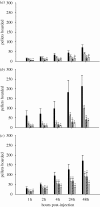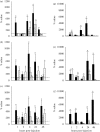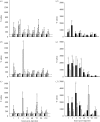Physiological mechanisms for food-hoarding motivation in animals
- PMID: 20156819
- PMCID: PMC2830250
- DOI: 10.1098/rstb.2009.0225
Physiological mechanisms for food-hoarding motivation in animals
Abstract
The study of ingestive behaviour has an extensive history, starting as early as 1918 when Wallace Craig, an animal behaviourist, coined the terms 'appetitive' and 'consummatory' for the two-part sequence of eating, drinking and sexual behaviours. Since then, most ingestive behaviour research has focused on the neuroendocrine control of food ingestion (consummatory behaviour). The quantity of food eaten, however, is also influenced by the drive both to acquire and to store food (appetitive behaviour). For example, hamster species have a natural proclivity to hoard food and preferentially alter appetitive ingestive behaviours in response to environmental changes and/or metabolic hormones and neuropeptides, whereas other species would instead primarily increase their food intake. Therefore, with the strong appetitive component to their ingestive behaviour that is relatively separate from their consummatory behaviour, they seem an ideal model for elucidating the neuroendocrine mechanisms underlying the control of food hoarding and foraging. This review focuses on the appetitive side of ingestive behaviour, in particular food hoarding, attempting to integrate what is known about the neuroendocrine mechanisms regulating this relatively poorly studied behaviour. An hypothesis is formed stating that the direction of 'energy flux' is a unifying factor for the control of food hoarding.
Figures





Similar articles
-
When do we eat? Ingestive behavior, survival, and reproductive success.Horm Behav. 2013 Sep;64(4):702-28. doi: 10.1016/j.yhbeh.2013.07.005. Epub 2013 Jul 30. Horm Behav. 2013. PMID: 23911282 Review.
-
RFamide-related Peptide-3 and the Trade-off between Reproductive and Ingestive Behavior.Integr Comp Biol. 2017 Dec 1;57(6):1225-1239. doi: 10.1093/icb/icx097. Integr Comp Biol. 2017. PMID: 28985338 Free PMC article.
-
AgRP knockdown blocks long-term appetitive, but not consummatory, feeding behaviors in Siberian hamsters.Physiol Behav. 2018 Jun 1;190:61-70. doi: 10.1016/j.physbeh.2017.10.008. Epub 2017 Oct 12. Physiol Behav. 2018. PMID: 29031552 Free PMC article.
-
Neuroendocrine regulation of appetitive ingestive behavior.Front Neurosci. 2013 Nov 15;7:213. doi: 10.3389/fnins.2013.00213. Front Neurosci. 2013. PMID: 24298235 Free PMC article. Review.
-
Mechanisms for AgRP neuron-mediated regulation of appetitive behaviors in rodents.Physiol Behav. 2018 Jun 1;190:34-42. doi: 10.1016/j.physbeh.2017.10.006. Epub 2017 Oct 12. Physiol Behav. 2018. PMID: 29031550 Free PMC article. Review.
Cited by
-
Increased feeding and food hoarding following food deprivation are associated with activation of dopamine and orexin neurons in male Brandt's voles.PLoS One. 2011;6(10):e26408. doi: 10.1371/journal.pone.0026408. Epub 2011 Oct 27. PLoS One. 2011. PMID: 22046281 Free PMC article.
-
Peripherally injected ghrelin and leptin reduce food hoarding and mass gain in the coal tit (Periparus ater).Proc Biol Sci. 2018 May 30;285(1879):20180417. doi: 10.1098/rspb.2018.0417. Proc Biol Sci. 2018. PMID: 29794047 Free PMC article.
-
Diet-Induced Obesity and Circadian Disruption of Feeding Behavior.Front Neurosci. 2017 Feb 7;11:23. doi: 10.3389/fnins.2017.00023. eCollection 2017. Front Neurosci. 2017. PMID: 28223912 Free PMC article. Review.
-
Paradoxical leanness in the imprinting-centre deletion mouse model for Prader-Willi syndrome.J Endocrinol. 2017 Jan;232(1):123-135. doi: 10.1530/JOE-16-0367. Epub 2016 Oct 31. J Endocrinol. 2017. PMID: 27799465 Free PMC article.
-
PYY(3-36) into the arcuate nucleus inhibits food deprivation-induced increases in food hoarding and intake.Peptides. 2013 Sep;47:20-8. doi: 10.1016/j.peptides.2013.05.005. Epub 2013 Jun 29. Peptides. 2013. PMID: 23816798 Free PMC article.
References
-
- Ahima R. S., Prabakaran D., Mantzoros C. S., Qu D., Lowell B. B., Maratos-Flier E., Flier J. S.1996Role of leptin in the neuroendocrine response to fasting. Nature 382, 250–252 (doi:10.1038/382250a0) - DOI - PubMed
-
- Ariyasu H., et al. 2001Stomach is a major source of circulating ghrelin, and feeding state determines plasma ghrelin-like immunoreactivity levels in humans. J. Clin. Endocrinol. Metab. 86, 4753–4758 (doi:10.1210/jc.86.10.4753) - DOI - PubMed
-
- Asakawa A., et al. 2001Ghrelin is an appetite-stimulatory signal from stomach with structural resemblance to motilin. Gastroenterology 120, 337–345 (doi:10.1053/gast.2001.22158) - DOI - PubMed
-
- Atcha Z., Cagampang F. R., Stirland J. A., Morris I. D., Brooks A. N., Ebling F. J., Klingenspor M., Loudon A. S.2000Leptin acts on metabolism in a photoperiod-dependent manner, but has no effect on reproductive function in the seasonally breeding Siberian hamster (Phodopus sungorus). Endocrinology 141, 4128–4135 (doi:10.1210/en.141.11.4128) - DOI - PubMed
-
- Bagnasco M., Tulipano G., Melis M. R., Argiolas A., Cocchi D., Muller E. E.2003Endogenous ghrelin is an orexigenic peptide acting in the arcuate nucleus in response to fasting. Regul. Pept. 111, 161–167 (doi:10.1016/S0167-0115(02)00283-5) - DOI - PubMed
Publication types
MeSH terms
Substances
Grants and funding
LinkOut - more resources
Full Text Sources

